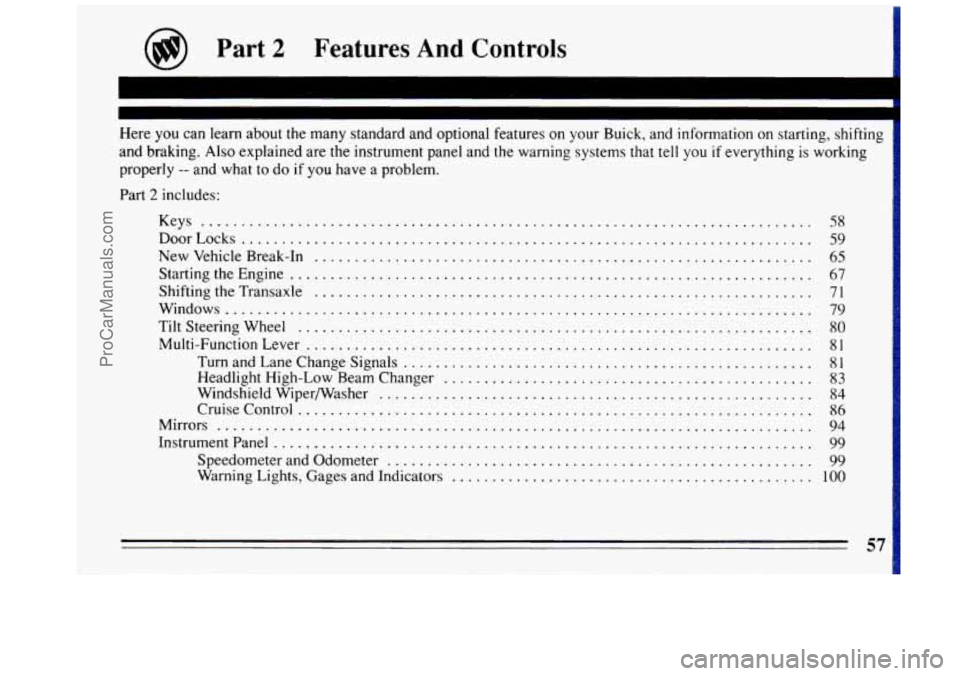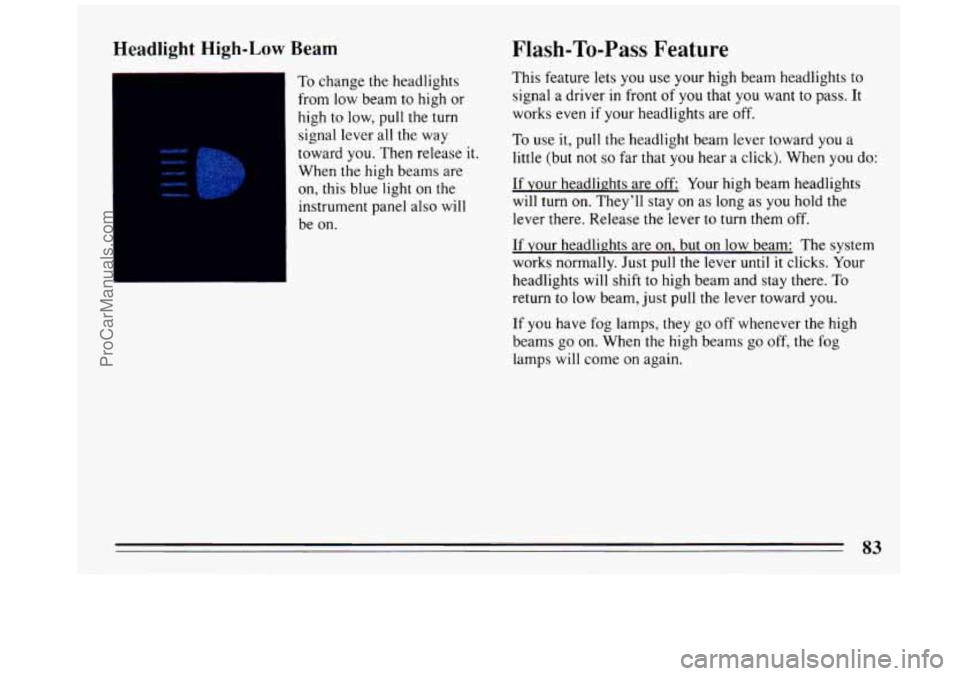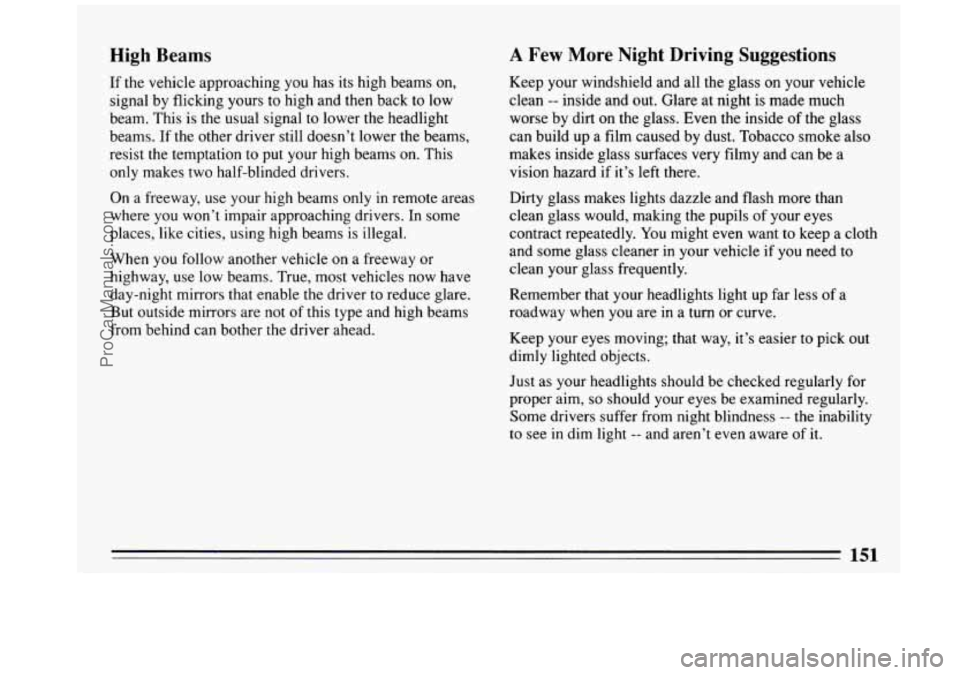1993 BUICK REGAL low beam
[x] Cancel search: low beamPage 59 of 308

'art 2 Features And Controls
Here you can learn about the many standard and optional features on your Buick. and information on .. starting. shifting ..
and braking . Also explained are the instrument panel and
properly
.. and what to do if you have a problem .
Part 2 includes: the warning
systems that tell you
if every
Thing is working
Keys ........................................................................\
....
DoorLocks ....................................................................... \
NewVehicleBreak-In ..............................................................
StartingtheEngine .................................................................
ShiftingtheTransaxle ..............................................................
Windows ........................................................................\
.
TiltSteeringWheel ................................................................
Multi-FunctionLever ...............................................................
TurnandI, aneChangeSignals ...................................................
Headlight High-Low Beam Changer ..............................................
WindshieldWiper/Washer ......................................................
Cruisecontrol ................................................................
Mirrors ........................................................................\
..
Instrumentpanel ...................................................................
Speedometer and Odometer .....................................................
Warning Lights, Gages and Indicators .............................................
58
59
65
67
71
79
80
81
81
83
84
86
94
99
99
100
ProCarManuals.com
Page 83 of 308

To tilt the wheel, hold the steering wheel and pull the
lever. Move the steering wheel to a comfortable level,
then release the lever to lock the wheel in place.
The Turn Signal/Headlight Beam
Lever
TE
If
The lever on the left side of the steering column
includes your:
0 Turn Signal and Lane Change Indicator
0 Headlight High-Low Beam & Passing Signal
0
0
0
0
Flash-To-Pass Feature
Windshield Wipers
Windshield Washer
Cruise Control (Option)
Turn Signal and Lane Change
Indicator
The turn signal has two upward (for Right) and two
downward (for Left) positions. These positions allow
you to signal a turn or a lane change.
81
ProCarManuals.com
Page 84 of 308

To signal a turn, move the lever all the way up or down.
When the turn
is finished, the lever will return
automatically.
A green arrow on the
instrument panel will flash in the direction of the turn
or lane change.
To signal a lane change, just raise or lower the lever
until the green arrow starts to flash. Hold it there
until
you complete your lane change. The lever will return by
itself when
you release it.
As you signal a turn or a lane change, if the arrows don’t
flash but just stay
on, a signal bulb may be burned out
and other drivers won’t see your
turn signal. If
a bulb
is burned out, replace it to help avoid an
accident. If the green arrows don’t
go on at all when you
signal a turn, check the fuse (see “Fuses” in the Index)
and for burned-out bulbs.
Turn Signal “ON” Chime
A chime will sound if your turn signal is left on after
having gone
3/4 mile, to remind you to turn your signal
off.
Operation of Lights
Although your vehicle’s lighting system (headlights,
parking lights, fog lamps, side marker lights and
taillights) meet
all applicable federal lighting
requirements, certain states and provinces may apply
their own lighting regulations that may require special
attention before you operate these lights. For example,
some jurisdictions may require that you operate your
lower beam lights with fog lamps at all times, or that
headlights be turned on whenever you must use your
windshield wipers. In addition,
most jurisdictions
prohibit driving solely with parking lights, especially at
dawn or dusk. It is recommended that you check with
you own state or provincial highway authority for
applicable lighting regulations.
82
-
ProCarManuals.com
Page 85 of 308

Headlight High-Low Beam
rc
To change the headlights
from low beam to high or
high to low, pull the turn
signal lever all the way
toward you. Then release
it.
When the high beams are
on, this blue light on the
instrument panel also will
be on.
Flash-To-Pass Feature
This feature lets you use your high beam headlights to
signal a driver
in front of you that you want to pass. It
works even if your headlights are off.
To use it, pull the headlight beam lever toward you a
little (but
not so far that you hear a click). When you do:
If your headlights are off Your high beam headlights
will
turn on. They’ll stay on as long as you hold the
lever there. Release the lever
t.o turn them off.
If your headliphts are on, but on low beam: The system
works normally. Just pull the lever until
it clicks. Your
headlights will shift to high beam and stay there.
To
return to low beam, just pull the lever toward you.
If
you have fog lamps, they go off whenever the high
beams go on. When the high beams
go off, the fog
lamps will come
on again.
83
ProCarManuals.com
Page 94 of 308

Headlight “On” Warning
If the light switch is left on you’ll hear a warning tone
when you turn the ignition
off and open the driver’s
door.
Fog Eights (GS Only Option)
If you have the fog light
feature, the control is on the
instrument. The parking
lights must be on, for the
fog lights to work. The fog
lights will turn off
when
you switch to high beam
headlights. When you
switch back to
low beam
headlights they
will turn
back on.
Daytime Running Lights (Canada Only)
The Canadian Federal Government has decided that
“Daytime Running Lights”
(DRL) are a useful feature,
in that DRL can make your vehicle more visible to
pedestrians and other drivers during daylight hours.
DRL are required on new vehicles sold
in Canada.
Your DRL work
with a light sensor on top of the
instrument panel. Don’t cover
it up.
The low beam headlights will come on at reduced
brightness
in daylight when:
0 The ignition is on
The headlight switch is off, and
The parking brake is released.
At dusk, the exterior lights will come on automatically
and the low beams will change to.full brightness.
At
dawn, the exterior lights will go out and the low beams
will change to the reduced brightness of DRL (if the
headlight switch
is off>. Of course, you may still turn on
the headlights any time you need to. To idle your vehicle
with the DRL off. set the parking brake while the
ignition
is in the “Off“ or “l,ock” position. Then start
the vehicle. The DRL
will stay off until you release the
parking brake.
92
ProCarManuals.com
Page 147 of 308

What should you do if this ever happens? Let up on the
brake or accelerator pedal, steer the vehicle the way you
want it to
go, and slow down.
Speed limit signs near curves warn that
you should
adjust your speed. Of course, the posted speeds are
based on good weather and road conditions. Under less
favorable conditions you’ll want to
go slower.
If you need to reduce your speed as
you approach a
curve, do it before
you enter the curve, while your front
wheels are straight ahead.
Try to adjust your speed
so you can “drive” through the
curve. Maintain a reasonable, steady speed. Wait to
accelerate until you are out
of the curve, and then
accelerate gently
into the straightaway.
When you drive into a curve at night, it’s harder to see
the road ahead of you because it bends away from the
straight beams
of your lights. This is one good reason to
drive slower.
Steering in Emergencies
There are times when steering can be more effective
than braking. For example,
you come over a hill and
find a truck stopped in your lane, or a car suddenly pulls
out from nowhere, or a child darts out from between
parked cars and stops right in front
of you. You can
avoid these problems by braking
-- if you can stop in
time. But sometimes
you can’t; there isn’t room. That’s
the time for evasive action
-- steering around the
problem.
Your Buick can perform very well in emergencies like
these. First apply your brakes
-- but, unless you have
anti-lock, not enough to lock your wheels. It is better to
remove as much speed
as you can from a possible
collision. Then steer around the problem, to the left or
right depending on the space available.
An emergency like this requires close attention and a
quick decision. If you are holding the steering wheel at
the recommended
9 and 3 o’clock positions, you can
turn it a
full 180 degrees very quickly without removing
either hand.
Rut you have to act fast, steer quickly, and
just as quickly straighten
the wheel once you have
avoided the object. You must then be prepared
to steer
back to your original lane and then brake to a controlled
stop.
Depending on your speed, this can be rather violent for
an unprepared driver. This
is one of the reasons driving
1 AC
ProCarManuals.com
Page 152 of 308

Here are some tips on night driving.
0 Drive defensively. Remember, this is the most
dangerous time.
0 Don’t drink and drive. (See “Drunken Driving” in
the Index for more on this problem.)
0 Adjust your inside rearview mirror to reduce the
glare from headlights behind
you.
Since you can’t see as well, you may need to slow
down and keep more space between
you and other
vehicles. It’s hard
to tell how fast the vehicle ahead
is going just by looking at its taillights.
0 Slow down, especially on higher speed roads. Your
headlights can light up
only so much road ahead.
In remote areas, watch for animals.
0 If you’re tired, pull off the road in a safe place and
rest.
Night Vision
No one can see as well at night as in the daytime. But as
we get older these differences increase.
A 50-year-old
driver may require at least twice as much light
to see the
same thing at night as a 20-year-old. What
you do in the daytime can also affect your night
vision. For example, if you spend the day
in bright
sunshine
you are wise to wear sunglasses. Your eyes will
have less trouble adjusting to night.
But
if you’re driving, don’t wear sunglasses at night.
They may cut down on glare from headlights, but they
also make a lot of things invisible that should remain
visible
- such as parked cars, obstacles, pedestrians, or
even trains blocking railway crossings.
You may want to
put
on your sunglasses after you have pulled into a
brightly-lighted service or refreshment area. Eyes
shielded from that glare may adjust more quickly to
darkness back on the road. But be sure
to remove your
sunglasses before you leave the service area.
You can be temporarily blinded by approaching lights. It
can take a second or two, or even several seconds, for
your
eyes to readjust to the dark. When you are faced
with severe glare (as from a driver who doesn’t lower
the high beams, or a vehicle with misaimed headlights),
slow down a little. Avoid staring directly into
the
approaching lights. If there is a line of opposing traffic,
make occasional glances over the line of headlights
to
make certain that one of the vehicles isn’t starting to
move into your lane. Once you are past the bright lights,
give your eyes time to readjust before resuming speed.
150
ProCarManuals.com
Page 153 of 308

High Beams
If the vehicle approaching you has its high beams on,
signal by flicking yours
to high and then back to low
beam. This is the usual signal to lower the headlight
beams. If the other driver still doesn’t lower the beams,
resist the temptation to put your high beams on. This
only makes two half-blinded drivers.
On a freeway, use your high beams only in remote areas
where you won’t impair approaching drivers. In some
places, like cities, using high beams is illegal.
When
you follow another vehicle on a freeway or
highway, use low beams. True, most vehicles now have
day-night mirrors that enable the driver
to reduce glare.
But outside mirrors are not
of this type and high beams
from behind can bother the driver ahead.
A Few More Night Driving Suggestions
Keep your windshield and all the glass on your vehicle
clean
-- inside and out. Glare at night is made much
worse by dirt on the glass. Even the inside of the glass
can build up a film caused by dust. Tobacco smoke also
makes inside glass surfaces very filmy and can be
a
vision hazard if it’s left there.
Dirty glass makes lights dazzle and flash more than
clean glass would, making the pupils of your eyes
contract repeatedly.
You might even want to keep a cloth
and some glass cleaner in your vehicle if you need
to
clean your glass frequently.
Remember that your headlights light up far less of a
roadway when you are in a turn or curve.
Keep your eyes moving; that way, it’s easier to pick out
dimly lighted objects.
Just as your headlights should be checked regularly for
proper aim,
so should your eyes be examined regularly.
Some drivers suffer from night blindness
-- the inability
to see in dim light
-- and aren’t even aware of it.
151
ProCarManuals.com